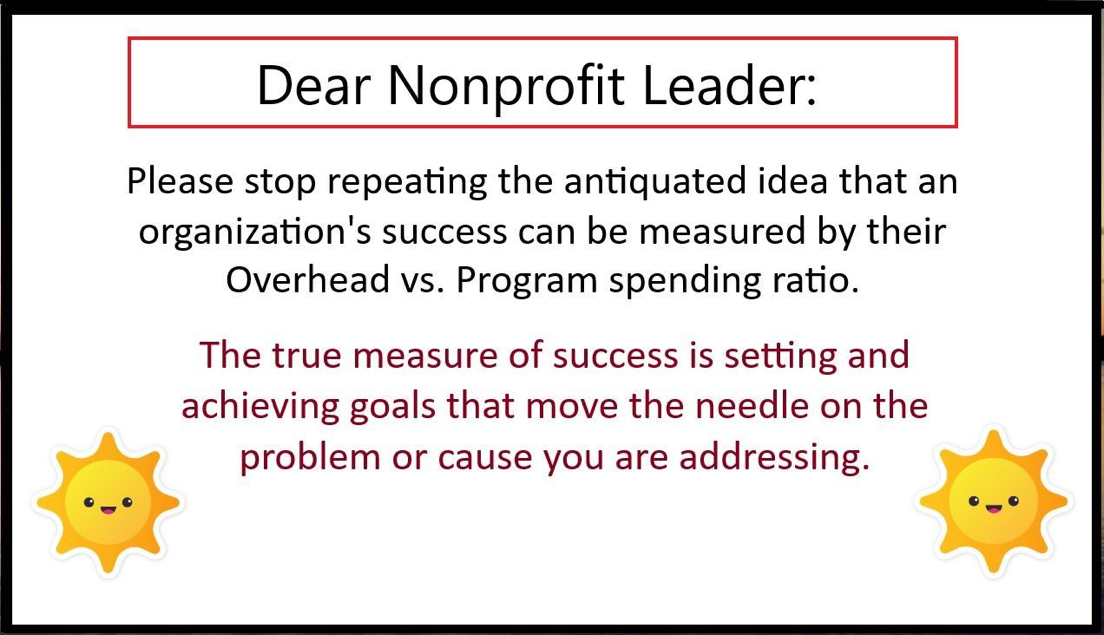In the world of nonprofits and social enterprises, there's a persistent myth that an organization’s success can be distilled into a single metric: the ratio of overhead to program spending. This outdated measure, often cited by donors and evaluators, suggests that organizations with lower overhead costs are more efficient and thus more effective. However, this simplistic view overlooks the true drivers of impact and can mislead both funders and organizations themselves. It’s time we reframe how we measure success and focus on what really matters: achieving meaningful goals.
[*With apologies to the image creator. This image inspired this post.]
The Overhead Myth
The overhead ratio—the percentage of funds spent on administrative and fundraising expenses versus those directly invested in programs—has long been a favored metric. It’s easy to calculate and seemingly intuitive: lower overhead suggests that more of every dollar goes directly to program services, while higher overhead implies inefficiency. However, this focus on overhead costs can be misleading.
Organizations with high overhead might be investing in crucial infrastructure like technology, staff development, or robust fundraising strategies. These investments can enhance overall effectiveness and sustainability, ultimately leading to greater impact. Conversely, a low overhead ratio doesn’t guarantee success. It might indicate underinvestment in essential areas, which could hinder an organization's ability to deliver quality programs or scale its impact.
The True Measure of Success
The real measure of an organization’s success is not how low their overhead costs are but how effectively they set and achieve goals that address the problems or causes they are committed to. Here’s why focusing on goals is a more meaningful approach:
- Impact Over Efficiency: Success should be defined by the extent to which an organization makes a tangible difference. For example, a nonprofit working to improve literacy rates should be judged by the number of individuals who improve their reading skills, not by how little they spend on administration.
- Goal Achievement: Effective organizations set clear, strategic goals aligned with their mission and measure their success based on the achievement of these goals. This includes evaluating the outcomes and changes they bring about in the communities they serve.
- Sustainable Growth: Investing in infrastructure, staff training, and innovation can enhance an organization’s capacity to achieve its mission more effectively in the long run. High-quality programs and services often require substantial investment in these areas.
- Comprehensive Evaluation: Success should be evaluated holistically. This means looking at both quantitative outcomes (like the number of people served or the amount of funds raised) and qualitative impacts (such as improvements in quality of life or systemic changes).
Embracing a New Perspective
As donors, evaluators, and organizational leaders, it’s crucial to adopt a broader perspective on success. Rather than fixating on overhead ratios, we should prioritize the effectiveness and impact of the programs and initiatives we support. This means asking questions like:
- How are we measuring progress toward our goals?
- What are the real-world outcomes of our programs?
- Are we investing in areas that will enhance our ability to achieve our mission?
By focusing on these aspects, we can ensure that resources are used effectively and that organizations are empowered to make meaningful progress. In the end, success is not about spending less on overhead but about making a substantial difference in the areas we care about. Let’s move beyond the outdated metrics of overhead ratios and embrace a more nuanced understanding of success. By concentrating on goal achievement and real-world impact, we can better support organizations in their quest to make a difference and drive positive change in the world.
